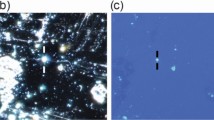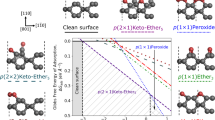Abstract
GRAPHITIZATION of diamond at ambient pressure was first observed in the 1920s1,2, but the mechanisms responsible for this transformation and, in particular, those underlying the nucleation and growth of graphite in diamond, remain controversial3–5. In addition to their fundamental interest, these processes have technological relevance—for example, for the growth by chemical vapour deposition6 of diamond-like films, which sometimes include graphitic islands7. Here we report the results of first-principles molecular dynamics simulations of a surface-induced diamond-to-graphite transition, which provide a microscopic model for the early stages of the graphitization process. We find that a well defined diamond/graphite interface forms during the transition; the electronic properties of the atoms at this interface suggest that they are highly chemically active sites. In addition to its relevance to graphite inclusion in diamond films, our model should yield insight into the process of selective etching in vapour-deposited carbon films, and possibly also into diamond nucleation.
This is a preview of subscription content, access via your institution
Access options
Subscribe to this journal
Receive 51 print issues and online access
$199.00 per year
only $3.90 per issue
Buy this article
- Purchase on Springer Link
- Instant access to full article PDF
Prices may be subject to local taxes which are calculated during checkout
Similar content being viewed by others
References
Friedel, G. & Ribaud, G. C.r. hebd. Séanc. Acad. Sci., Paris 178, 1126–1129 (1924).
Libeau, P. & Picon, M. C.r. hebd. Séanc. Acad. Sci., Paris 179, 1059–1061 (1924).
Nath, N. S. N. Proc. Indian Acad. Sci. A2, 143–152 (1935).
Evans, T. & James, P. F. Proc. R. Soc. Lond. A277, 260–269 (1964).
Davies, G. & Evans, T. Proc. R. Soc. Lond. A328, 413–427 (1972).
Spear, K. E. & Frenklach, M. Pure appl. Chem. 66, 1773–1782 (1994).
Zhu, W., Rendall, C. A., Badzian, A. R. & Messier, R. J. Vac. Sci. Technol. A7, 2315–2324 (1989).
Grenville-Wells, H. J. Mineralog. Mag. 29, 803–816 (1952).
Seal, M. Proc. 4th Int. Conf. on Electron Microscopy (ed. Ross, R.) 455–459 (Royal Microscopical Soc., London, 1958).
Bovenkerk, H. P., Bundy, F. P., Hall, H. T., Strong, H. M. & Wentorf, R. H. Nature 184, 1094–1098 (1959).
Rodewald, H. J. Helv. chim. Acta 43, 1657–1666 (1960).
Bundy, F. P., Hall, H. T., Strong, H. M. & Wentorf, R. H. J. chem. Phys. 35, 383–391 (1961).
Car, R. & Parrinello, M. Phys. Rev. Lett. 55, 2471–2474 1985).
Iarlori, S., Galli, G., Gygi, F., Parrinello, M. & Tosatti, E. Phys. Rev. Lett. 69, 2947–2950 (1992).
De Vita, A. et al. EPFL Superconducting J. 6, 22–27 (1994).
Nosé, S. Molec. Phys. 52, 255–262 (1984).
Hoover, W. Phys. Rev. A31, 1695–1697 (1985).
Li, Z. et al. J. appl. Phys. 73, 711–715 (1993).
Lambrecht, W. R. L. et al. Nature 364, 607–609 (1993).
Klein, D. J. Chem. Phys. Lett. 217, 261–265 (1993).
Balaban, A. T., Klein, D. J. & Folden, C. A. Chem. Phys. Lett. 217, 266–270 (1993).
Jungnickel, G. et al. Bull. Am. phys. Soc. 40, 772 (1995).
Jungnickel, G. et al. Mater. Res. Symp. Proc. 383, 349–360 (1995).
Davidson, B. & Pickett, W. Phys. Rev. B49, 11253–11256 (1994).
Mehandru, S. P., Anderson, A. B. & Angus, J. C. J. phys. Chem. 96, 10978–10982 (1992).
Angus, J. C., Will, H. A. & Stanko, W. S. J. appl. Phys. 39, 2915–2922 (1968).
Bachelet, G. B., Hamann, D. & Schlüter, M. Phys. Rev. B26, 4199–4228 (1982).
Troullier, N. & Martins, J. L. Phys. Rev. B43, 1993–2006 (1991).
Fahy, S., Louie, S. & Cohen, M. L. Phys. Rev. B34, 1191–1199 (1986).
Weast, R. C. (ed.) CRC Handbook of Chemistry and Physics 75th edn D-58 (CRC, Boca Raton, Florida 1988).
Author information
Authors and Affiliations
Rights and permissions
About this article
Cite this article
De Vita, A., Galli, G., Canning, A. et al. A microscopic model for surface-induced diamond-to-graphite transitions. Nature 379, 523–526 (1996). https://doi.org/10.1038/379523a0
Received:
Accepted:
Issue Date:
DOI: https://doi.org/10.1038/379523a0
This article is cited by
-
Progress and prospect of diamond dynamic friction polishing technology
The International Journal of Advanced Manufacturing Technology (2023)
-
Electronic-structure methods for materials design
Nature Materials (2021)
-
Complex nanostructures in diamond
Nature Materials (2020)
-
Extremely rapid isotropic irradiation of nanoparticles with ions generated in situ by a nuclear reaction
Nature Communications (2018)
-
Microstructure and graphitization behavior of diamond/SiC composites fabricated by vacuum vapor reactive infiltration
Rare Metals (2015)
Comments
By submitting a comment you agree to abide by our Terms and Community Guidelines. If you find something abusive or that does not comply with our terms or guidelines please flag it as inappropriate.



